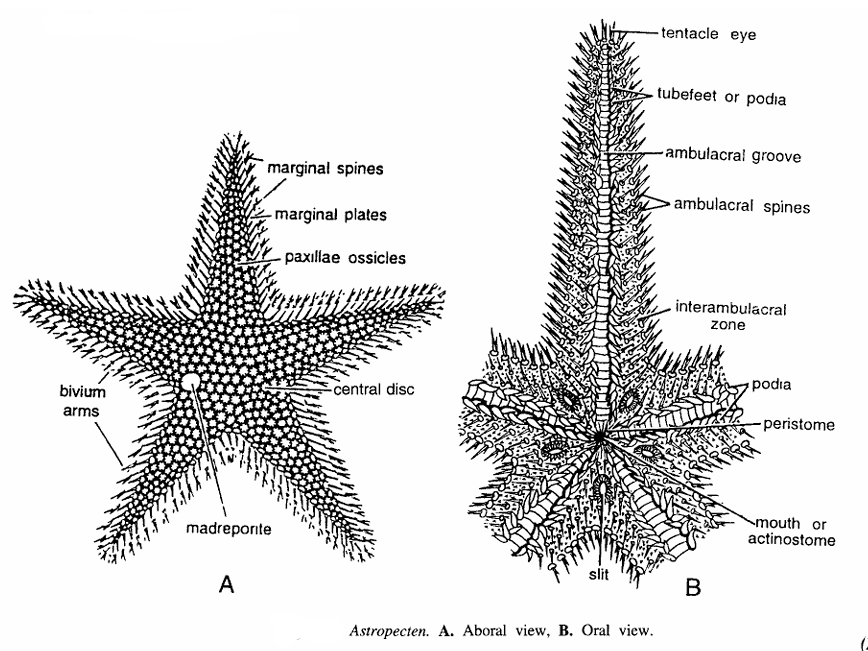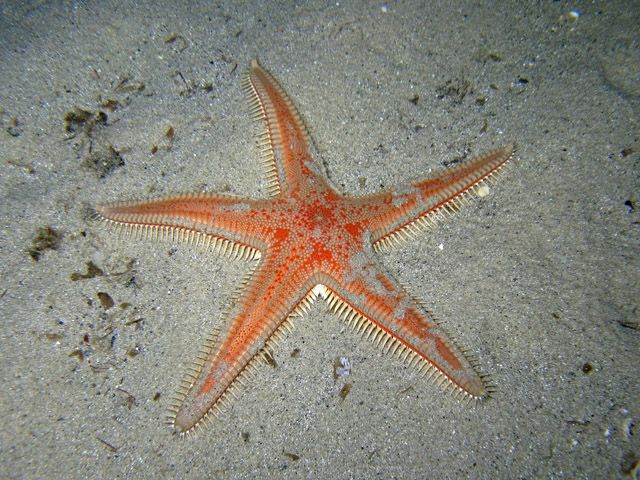Astropecten: Morphology, Classification, Habitat, and Ecological Role of Sand Sea Stars
Astropecten is a genus of sea stars belonging to the family Astropectinidae, commonly referred to as sand sea stars or comb sea stars. These starfish are adapted to live in sandy or silty sediment habitats where they often remain partially buried during the day and actively forage for prey at night or during low light conditions. Astropecten species are distributed throughout tropical and subtropical seas worldwide. They have distinctive long arms edged with comb-like spines and pointed tube feet that aid in burrowing and locomotion. Their feeding behavior includes swallowing prey whole, distinguishing them from many other starfish species.
Classification of Astropecten
| Taxonomic Rank | Name | Characteristic Features |
|---|---|---|
| Kingdom | Animalia | Multicellular, eukaryotic animals |
| Phylum | Echinodermata | Marine animals with radial symmetry and spiny skin |
| Class | Asteroidea | Star-shaped echinoderms with tube feet |
| Order | Paxillosida | Starfish without suckered tube feet and with spiny arms |
| Family | Astropectinidae | Sand sea stars with comb-like marginal spines |
| Genus | Astropecten | Sea stars with broad arms, long spines, and pointed tube feet |

Habit and Habitat
Astropecten species predominantly inhabit sandy and muddy sea bottoms in shallow to moderately deep waters, often ranging from the intertidal zone down to several hundred meters depth. These starfish are capable of rapid movement on soft substrates and frequently bury themselves in sediment to avoid predators or extreme conditions. They are mostly nocturnal, emerging in low light to feed.
Geographical Distribution
Species of Astropecten are found worldwide in tropical and subtropical seas, including the Indo-Pacific region, the Mediterranean Sea, parts of the Atlantic Ocean, and other coastal waters where sandy bottoms occur.

General Characteristics
- Commonly called as starfish. Body is star-shaped, conslstmg of flattened five-pointed central disc with 5 short flexible, triangular arms with tapering tips. Oral and aboral surfaces are distinctly marked.
- Body is covered by a soft transparent skin through which skeleton could be seen.
- Oral surface contains centrally-placed mouth, which communicates with 5 broadly opened ambulacral grooves having double rows or tube feet.
- Mouth is very widely distensible which can swallon bivalves, molluscs, snails and crustaceans very easily.
- Infra-marginal plates are elongated and meet the adambulacral to form the oral surface of the anns.
- Arms are distinctly marked off from the central disc but do not contain prolongations of either the perivisceral coelom or the gut.
- Mouth is very widely distensible, which can swallow bivalves, molluscs, snails and crustaceans very easily.
- Aboral surface has madreporite in one of the interradii.
- Skin is soft and somewhat transparent and internal skeleton is seen from outside.
- Aboral surface contains blunt spines, finger-like dermal branchiae and pedicellariae.
- In some forms spines are absent. Sexes are separate. The development includes brachiolaria larva.
- Body Form: Flattened central disc with five broad, tapering arms.
- Surface: The aboral surface is covered with paxillae—small pillar-like structures topped with flattened clusters of spines.
- Arms: Edged with rows of long, sharp, comb-like spines that facilitate burrowing.
- Tube Feet: Pointed and non-suckered tube feet adapted for movement across sandy substrates.
- Coloration: Varies across species but often includes shades of yellow, orange, brown, and sometimes purplish tones.
- Size: Arm span usually ranges from 5 to 20 cm, varying by species and habitat.
Special Features
- Feeding Behavior: Carnivorous, feeding on buried mollusks and other small invertebrates by swallowing them whole.
- Locomotion: Uses pointed tube feet for digging and fast crawling on sand.
- Burrowing Ability: Can rapidly bury themselves in sediment to escape predators.
- Reproduction: Separate sexes with external fertilization; larval stages are planktonic before settlement.
- No Stomach Eversion: Unlike other starfish, Astropecten does not evert its stomach to digest prey outside its body.

Identification
Key characteristics for identifying Astropecten species include:
- Shape and arrangement of marginal plates and spines.
- Arm length and tapering degree.
- Color patterns on aboral surface.
- Size and habitat preferences.
- Distinctive comb-like spines on arm margins.
Life Cycle and Reproduction
Astropecten reproduces sexually with external fertilization; larvae undergo planktonic bipinnaria stages before settling to the benthos. Juveniles gradually develop the adult star-like form. Reproductive timing and success often depend on environmental factors such as temperature and food availability.
Ecological Role and Importance
Astropecten sea stars play important roles as benthic predators and scavengers, helping regulate populations of buried mollusks and other invertebrates. Their burrowing activity influences sediment structure and water quality, contributing to overall marine ecosystem health. They are indicators of sandy-bottom habitat biodiversity.
References
- https://en.wikipedia.org/wiki/Astropecten
- https://en.wikipedia.org/wiki/Astropecten_polyacanthus
- https://www.marlin.ac.uk/species/detail/2013
- https://www.sealifebase.se/summary/Astropecten-articulatus.html
- http://www.wildsingapore.com/wildfacts/echinodermata/asteroidea/astropecten.htm
- https://www.sciencedirect.com/science/article/pii/S0141113615300763
- https://animaldiversity.org/accounts/Astropecten/classification/
- https://www.britannica.com/animal/Astropecten

